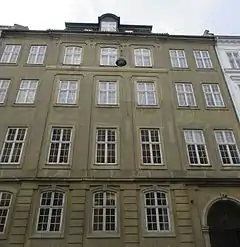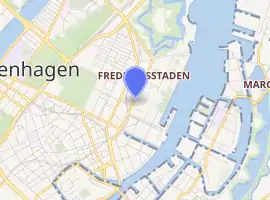Royal Danish Silk Manufactury
The Royal Danish Silk Manufactury (Danish: Den Kongelige Silkemanufaktur) was located at Bredgade 34 and 36 in Copenhagen, Denmark. The building fronting the street at No. 34 was listed on the Danish registry of protected buildings and places by the Danish Heritage Agency on 12 March 1951.[1] The rear wings and the building at No.36 are not listed.
| Royal Danish Silk Manufactury | |
|---|---|
Den Kongelige Silkemanufaktur | |
 | |

| |
| General information | |
| Location | Bredgade 36, Copenhagen |
| Country | Denmark |
| Coordinates | 55°41′1.09″N 12°35′23.63″E |
| Completed | 1756 |
History
The Royal Silk Manufactory was originally established by John Beckett at the corner of Store Kongensgade (No. 83) and Hindegade in 1739. It was destroyed by fire but was rebuilt by his successor, Charles Maillot (1718-1745), a Frenchman, with support from the kommercekollegiet, in 1742. The new factory was built by Philip de Lange. It was destroyed by fire in 1745, It was rebuilt but went bankrupt shortly thereafter. Maillot left the country but died in Quebec later that same year.[2]
Peter Reiersen (1713-1773), who had been appointed as bookkeeper at Almindelige Varemagasin in 1738, managed to revive the operations. It had 43 looms and 143 workers.
A large mew factory complex was constructed in Bredgade in 1755-56. Reiersen answered to four directors: Gilles Willhelm Daemen (1702-1787), Conrad Christian Dauw (1693-1775), Peter van Hurk (1667-1775) and Cornelius Schumacher (1703-1777). The latter was married to Reiersen's sister, Elisabeth Reiersen (1718-1755).

The production stagnated in the 1770s. In earky 1775 it was taken over by Niels Lunde Reiersen. At this point the number of employees had fallen to 28 weavers and approximately one hundred workers.
After Lunde Reiersen's death in 1795 it was taken over by his business partner Hans Brandorph. He lived with his family in one of the apartments. Friderich Hoppe (1770-1837), the owner of Rosenfeldt at Vordingborg and a board member of the Reiersen Foundation, lived in another apartment.
He went bankrupt in 1802. The silk production was for a while revived by John Baverstock with support from kommercekollegiet. John and Robert (Richard?) Baverstock had together with four silk workers come to Copenhagen from London to establish a silk production.
.jpg.webp)
The factory was in 1806 sold to Charles aigist Selby, Frédéric de Coninck, Jean de Coninck and William Duntzfelt. In 18011, it was sold to Jean Frederik Christian Gandil (1791-1840). In 1813 to 1825, it was owned by Ulrich Christian von Schmidten and Ole Christian Borch. The complex was acquired by Johan Carl Modeweg in 1825 and once again turned into a textile factory but he moved the production to Brede Works in 1831.[3]
The complex was later home to Bredgade Steam Mill. It closed in 1897. The buildings were then acquired by piano manufacturer Hindsberg.[4]
Several prominent residents have also lived in the complex. The later Minister of Defence Christian Frederik Hansen lived at No. 34 in 1824-1825. The composer [[]] lived at No. 34 from 1874 to 1884.[5]
Architecture
The complex is centred on two courtyards. The architect was possibly Niels Eigtved. The building fronting the street served as headquarters and also contained a residence for the manager.
List of owners
- (1756-59) The Crown wuth Peter Reiersen as leader
- (760-73) Peter Reiersen
- (1775-1796) Niels Lunde Reiersen
- (1796-1806) Hans Brandorph
- (1806-1811) Charles August Selby, Frédéric de Coninck, Jean de Coninck and William Duntzfelt
- (1811-1813) Frederik Christian Gandil
- (1813-1825) Ulrich Christian von Schmidten and Ole Christian Borch
See also
References
- "Sag: Den Kgl. Silkemanufaktur (tidl.)". Kulturstyrelsen (in Danish). Retrieved 17 March 2017.
- Ida Haugsted. "Silkefabrikken Bredgade 34-36 for-og baghuse". idahaugsted.dk (in Danish). Retrieved 2 June 2020.
- "I. C. Modewegs klædefabrik i København 1810-1832". Selskabet for Københavns Historie (in Danish). Retrieved 17 March 2017.
- "Den Kongelige Silkemanufaktur". Kulturstyrelsen (in Danish). Retrieved 17 March 2017.
- "Bredgade 34-34a-g". indenforvoldene.dk (in Danish). Retrieved 17 March 2017.